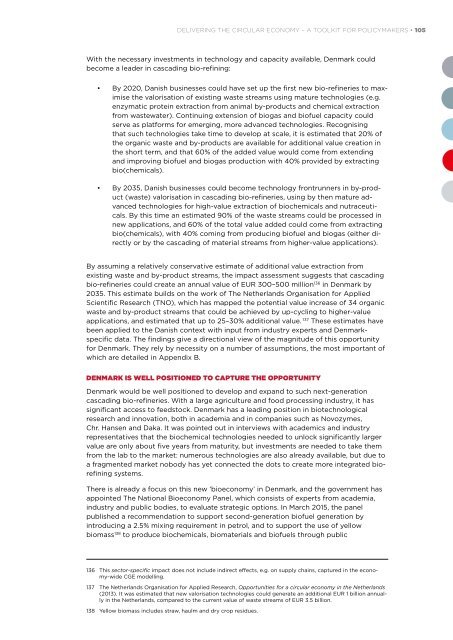DELIVERING THE CIRCULAR ECONOMY A TOOLKIT FOR POLICYMAKERS
20150924_Policymakers-Toolkit_Active-links
20150924_Policymakers-Toolkit_Active-links
Create successful ePaper yourself
Turn your PDF publications into a flip-book with our unique Google optimized e-Paper software.
<strong>DELIVERING</strong> <strong>THE</strong> <strong>CIRCULAR</strong> <strong>ECONOMY</strong> – A <strong>TOOLKIT</strong> <strong>FOR</strong> <strong>POLICYMAKERS</strong> • 105<br />
With the necessary investments in technology and capacity available, Denmark could<br />
become a leader in cascading bio-refining:<br />
• By 2020, Danish businesses could have set up the first new bio-refineries to maximise<br />
the valorisation of existing waste streams using mature technologies (e.g.<br />
enzymatic protein extraction from animal by-products and chemical extraction<br />
from wastewater). Continuing extension of biogas and biofuel capacity could<br />
serve as platforms for emerging, more advanced technologies. Recognising<br />
that such technologies take time to develop at scale, it is estimated that 20% of<br />
the organic waste and by-products are available for additional value creation in<br />
the short term, and that 60% of the added value would come from extending<br />
and improving biofuel and biogas production with 40% provided by extracting<br />
bio(chemicals).<br />
• By 2035, Danish businesses could become technology frontrunners in by-product<br />
(waste) valorisation in cascading bio-refineries, using by then mature advanced<br />
technologies for high-value extraction of biochemicals and nutraceuticals.<br />
By this time an estimated 90% of the waste streams could be processed in<br />
new applications, and 60% of the total value added could come from extracting<br />
bio(chemicals), with 40% coming from producing biofuel and biogas (either directly<br />
or by the cascading of material streams from higher-value applications).<br />
By assuming a relatively conservative estimate of additional value extraction from<br />
existing waste and by-product streams, the impact assessment suggests that cascading<br />
bio-refineries could create an annual value of EUR 300–500 million 136 in Denmark by<br />
2035. This estimate builds on the work of The Netherlands Organisation for Applied<br />
Scientific Research (TNO), which has mapped the potential value increase of 34 organic<br />
waste and by-product streams that could be achieved by up-cycling to higher-value<br />
applications, and estimated that up to 25–30% additional value. 137 These estimates have<br />
been applied to the Danish context with input from industry experts and Denmarkspecific<br />
data. The findings give a directional view of the magnitude of this opportunity<br />
for Denmark. They rely by necessity on a number of assumptions, the most important of<br />
which are detailed in Appendix B.<br />
DENMARK IS WELL POSITIONED TO CAPTURE <strong>THE</strong> OPPORTUNITY<br />
Denmark would be well positioned to develop and expand to such next-generation<br />
cascading bio-refineries. With a large agriculture and food processing industry, it has<br />
significant access to feedstock. Denmark has a leading position in biotechnological<br />
research and innovation, both in academia and in companies such as Novozymes,<br />
Chr. Hansen and Daka. It was pointed out in interviews with academics and industry<br />
representatives that the biochemical technologies needed to unlock significantly larger<br />
value are only about five years from maturity, but investments are needed to take them<br />
from the lab to the market: numerous technologies are also already available, but due to<br />
a fragmented market nobody has yet connected the dots to create more integrated biorefining<br />
systems.<br />
There is already a focus on this new ‘bioeconomy’ in Denmark, and the government has<br />
appointed The National Bioeconomy Panel, which consists of experts from academia,<br />
industry and public bodies, to evaluate strategic options. In March 2015, the panel<br />
published a recommendation to support second-generation biofuel generation by<br />
introducing a 2.5% mixing requirement in petrol, and to support the use of yellow<br />
biomass 138 to produce biochemicals, biomaterials and biofuels through public<br />
136 This sector-specific impact does not include indirect effects, e.g. on supply chains, captured in the economy-wide<br />
CGE modelling.<br />
137 The Netherlands Organisation for Applied Research, Opportunities for a circular economy in the Netherlands<br />
(2013). It was estimated that new valorisation technologies could generate an additional EUR 1 billion annually<br />
in the Netherlands, compared to the current value of waste streams of EUR 3.5 billion.<br />
138 Yellow biomass includes straw, haulm and dry crop residues.



